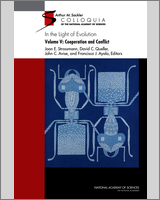NCBI Bookshelf. A service of the National Library of Medicine, National Institutes of Health.
Strassman JE, Queller DC, Avise JC, et al., editors. In the Light of Evolution: Volume V: Cooperation and Conflict. Washington (DC): National Academies Press (US); 2011.

In the Light of Evolution: Volume V: Cooperation and Conflict.
Show detailsIt is remarkable that a field founded on the concept of selfish genes (Dawkins, 1976b) got so far for so long without paying much attention to specifiable genes. That is probably because we learned how phenotypic strategies of cooperation and conflict could be understood as the results of genes maximizing inclusive fitness. However, studies at the genic level are now becoming common and should shed light both on the mechanisms and the manner in which social selection operates.
In Chapter 8, Brielle Fischman and colleagues review and extend what is known about the molecular genetic mechanisms of eusociality. Some of the information comes from studies of particular genes and pathways but much is now coming from evolutionary analyses of genome-scale data. To the seven sequenced genomes of social insects, the authors add their own transcriptome-based protein-coding sequences for 10 social and nonsocial bee species, representing three origins of sociality. Some of the patterns are idiosyncratic. For example, early results from the honeybee genome pointed to the importance of odorant receptors and immunity genes, but these do not hold up in the broader analyses. New findings include increased rates of evolution of brain-related genes in the primitively eusocial bees, conceivably because of the increased cognitive demands of their competitive social environment. Juvenile hormone and insulin are often important in caste. This is not surprising if caste is nutritionally based, although the effects of juvenile hormone are quite different than in nonsocial insects. There is also a rapid evolutionary change in proteins involved in fundamental carbohydrate metabolism. Again, this fits with a nutritional basis for caste, but it seems surprising that changes are common in such basic pathways. These issues should be clarified with additional genome sequences and functional studies of individual species.
In Chapter 9, Joan Strassmann and David Queller explore a microbial social system where it is possible to manipulate genes. In the social amoeba Dictyostelium discoideum, starved cells come together in large groups in which 20% of the cells sacrifice themselves to make a stalk that aids in dispersal of the others as spores (Kessin, 2001). Besides this impressive altruism, this species has been shown to have cheating, kin recognition, and even primitive farming of their bacterial food. Numerous genes of many functional types can be mutated to cheaters. Some cheaters could destroy cooperation, yet cooperation is maintained for a variety of reasons, one being the rather high genetic relatedness in the field, part of which is due to kin recognition mediated by highly polymorphic adhesion genes. Other controls on cheating that have been demonstrated include the evolution of resistor genes, power asymmetries, and lottery-like mechanisms. Studies of the dimA and csaA genes have shown that cheating can also be controlled by idiosyncratic pleiotropies of particular genes. The cheating allele would be favored by selection but other deleterious effects of the same allele keep it from spreading, suggesting that cheat-proof cooperation often may be built using elements that are essential for other reasons. Consistent with ongoing social conflicts and arms races, social genes evolve rapidly.
Dawkins (1976b) argued that all genes are selfish, but the ones that show the trait most distinctively are selfish genetic elements. These are the renegades of the genome, chunks of DNA that replicate in part at least via different pathways than most genes and thus can be selected to conflict with other loci. Transposons, for example, increase their representation by jumping from one place to another, often at some cost to the organism. Other examples include meiotic drive elements, various modification-rescue systems, imprinted genes, B chromosomes, and organellar genes. In Chapter 10, John Werren tackles the issues of the function and adaptation of these elements. He surveys the evidence, sometimes strong and sometimes suggestive, that such elements have had important functional consequences for their genomes. For example, parts of transposons sometimes evolve into regulatory regions, and defenses against selfish elements may have led to the eukaryotic intron-splicing apparatus. But contrary to some recent suggestions, Werren argues that there is as yet little evidence that these are the adaptive reasons for the maintenance of these elements. Instead, selfish genetic elements are maintained by their selfish behavior, but the new chunks of DNA that they sprinkle throughout genomes sometimes get co-opted, domesticated, or otherwise modified to cause some beneficial effect to the organism.
Contents
- REAL SELFISH (AND COOPERATIVE) GENES - In the Light of EvolutionREAL SELFISH (AND COOPERATIVE) GENES - In the Light of Evolution
- Mus musculus Ly1 antibody reactive clone (Lyar), transcript variant 12, mRNAMus musculus Ly1 antibody reactive clone (Lyar), transcript variant 12, mRNAgi|2581661961|ref|NM_001424431.1|Nucleotide
Your browsing activity is empty.
Activity recording is turned off.
See more...